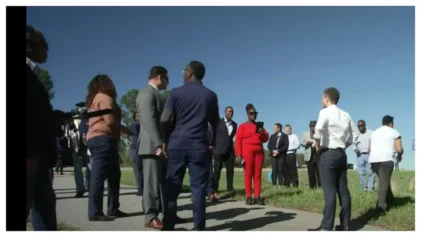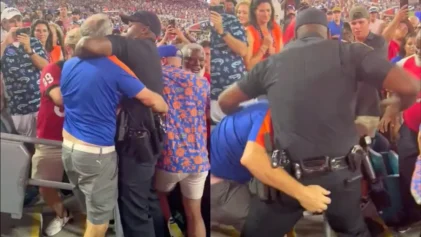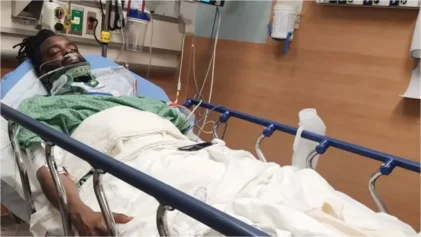In a vociferous defense of the controversial stop-and-frisk policy, New York Mayor Michael Bloomberg accused critics of the practice, which is the subject of an ongoing lawsuit, of trying to make the city less safe.
The mayor even lashed out at the New York Times for failing to cover the senseless murder of a 17-year-old black boy—the kind of crime that he said could be prevented by stop-and-frisk.
Bloomberg invoked both the Boston Marathon bombings and the 9/11 attack on the World Trade Center in defending stop-and-frisk, which is currently the target of two City Council bills. One bill would create an inspector general to oversee the police department and the other aims at abolishing racial profiling by officers.
“If the bills pass, they will make our city less safe and innocent people will [pay] a terrible price. My message is simple: stop playing politics with public safety. Look at what’s happened in Boston; remember what happened here on 9/11,” said the mayor.
It was not clear how the policy, which has been used overwhelmingly to stop black and Latino young males, would have prevented the Boston Marathon bombings or the hijacked airplanes from flying into the World Trade Center.
“The question is not whether the NYPD can continue driving crime to new record lows,” the mayor added. “The question is whether elected officials and special interest groups will allow you to.”
According to the New York Civil Liberties Union, police made 97,296 street stops in 2002, Bloomberg’s first year in office, growing to 685,724 stops in 2011 and 533,042 stops last year. Of the stops last year, according to the NYCLU, 89 percent resulted in no arrest or ticket—though testimony from the NYPD in federal court indicates the arrest percentage might be even lower, at 3.5 percent.
The 5 million young men who have been stopped over the past decade have been almost exclusively black and Latino.
But Bloomberg deflected the accusations that the policy is biased by accusing the New York Times of racism.
“Last week, a Bronx resident named Alphonza Bryant was shot and killed while standing with friends near his home. He was 17. Like most murder victims in our city, he was a minority,” Bloomberg told the crowd, which included Police Commissioner Ray Kelly. “He was just a victim of too many guns on our streets. After his murder, there was no outrage from the Center for Constitutional Rights or the NYCLU.
Alphonza Bryant“There was not even a mention of his murder in our paper of record, the New York Times. ‘All the news that’s fit to print’ did not include the murder of 17-year-old Alphonza Bryant.”
Bloomberg described the boy as an innocent bystander; police have said his murder was a case of mistaken identity.
“Do you think that if a white 17-year-old prep student from Manhattan had been murdered, the Times would have ignored it?” Bloomberg asked. “Me neither.”
Bryant was reportedly preparing for his prom and graduation from the Urban Assembly Bronx Studio for Writers and Artists, when he was shot near his home in Foxhurst at 8:15 p.m. on April 22 by someone who fired nine shots into the crowd.
Bloomberg said Bryant’s murder was exactly the kind of violent crime that stop-and-frisk prevents.
“If the NYPD conducted stops and intelligence-gathering based on demographic data rather than real leads, guns would be everywhere in our city, thousands of New Yorkers who are alive today would be dead and terrorists may well have succeeded in attacking us again,” Bloomberg said.
“And yet some in the City Council and some mayoral candidates are supporting legislation that would push the NYPD in that direction.”
Bryant’s mother later said she agreed with the mayor.
“If they would have stopped and frisked the guys who shot my son, maybe he would be alive today. We need stop-and-frisk. We need it to save our children’s lives,” a tearful Jenaii Van Doten, 46, told the New York Post after getting a tattoo of her son’s face on her right arm.
The mother, 46, said her son had been recently stopped.
“They’re [cops] not beating these kids up, they’re trying to get the guns off of them. My kid was stopped and frisked last month. He didn’t have a gun. If he did, his ass should have been in jail,” she said.
Bloomberg pointed out that “four days after Alphonza Bryant’s murder went unreported by the Times, the paper published another editorial attacking stop, question and frisk. They called it a ‘widely loathed’ practice, even though a growing number of mothers and fathers who have had their children murdered with guns have been speaking out in support of the practice.
“Let me tell you now what I loathe. I loathe that 17-year-old minority children can be senselessly murdered in the Bronx and some of the media doesn’t even consider it news,” he said.
But the Times and the NYCLU lashed back at the mayor.
“Mayor Bloomberg is trying to deflect criticism of the city’s stop-and-frisk practice by accusing the New York Times of bias,” said Danielle Rhoades Ha, a spokeswoman for the newspaper. She said criticism of the policy comes from editorial board, which operates separately from the news-gathering side of the organization.
“His claim of racial bias is absurd,” she said. “The Times aggressively covers violence in the city’s neighborhoods, and to select one murder as evidence to the contrary is disingenuous.”
NYCLU Executive Director Donna Lieberman said, “It’s a lot easier to trash the NYCLU than to acknowledge the widespread dissatisfaction the community feels with an NYPD that acts like it’s above the law and accountable to no one.”
During the trial over stop-and-frisk, now in its seventh week, Inspector Kenneth Lehr, commanding officer of the 67th precinct in Brooklyn, one of the busiest in the city, yesterday testified that he does not hear complaints from the public that stops by police are racially motivated. Lehr said since the population in the 67th precinct is 90 percent black and 7 percent Hispanic, it is logical that police stops would reflect those numbers.
But Lehr said it does bother him that only 3.5 percent of those stops lead to arrests, raising the possibility that officers are making stops without reasonable suspicion.
In March, after emotional testimony from young black males who had been affected by New York’s stop-and-frisk policy, the federal court heard from police officers who produced secret recordings to show that they are pressured by supervisors to stop black and Latino males to meet quotas — or risk punishment and retaliation.


